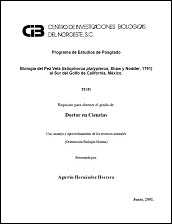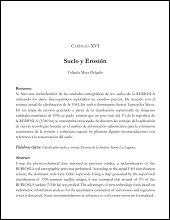Food habits of the yellow snapper Lutjanus argentiventris (Peters, 1869) (Percoidei: Lutjanidae) in La Paz Bay, Mexico
Hábitos alimenticios del pargo amarillo Lutjanus argentiventris (Peters, 1869) (Percoidei: Lutjanidae) en la Bahía de La Paz, México
Autor
ROSA ISELA VAZQUEZ SANCHEZ
JESUS RODRIGUEZ ROMERO
LEONARDO ANDRES ABITIA CARDENAS
FELIPE GALVAN MAGAÑA
Metadatos
Mostrar el registro completo del ítemResumen
"Se analizaron 304 estómagos del pargo amarillo Lutjanus argentiventris recolectados bimestralmente de abril 2003 a abril 2004, de los cuales 44% presentó alimento (44%). Se identificaron 54 tipos de presa. De acuerdo con el índice de importancia relativa (IIR), los huevos de peces (62%) y los peces Harengula thrissina (23%), Porichthys margaritatus (3,3%) y Abudefduf troschelii (2,3%) fueron las presas de mayor importancia en su dieta. En los juveniles, las presas de mayor importancia fueron la materia orgánica no identificada (32%), los crustáceos Upogebia pugettensis (29%) y los camarones peneidos (6,5%), así como los huevos de peces (5,2%). El índice de Levin determinó que la amplitud de la dieta fue baja (Bi= 0,0002), siendo considerado un depredador selectivo, mostrando un consumo preferencial por los huevos de peces y H. thrissina. El mismo resultado se obtuvo para machos (Bi=0,0002) y hembras (Bi=0,0009). Los juveniles mostraron una baja amplitud de dieta, consumiendo principalmente materia orgánica no identificada y U. pugettensis. El índice de Morisita-Horn mostró un traslapo significativo en la dieta por sexo, (C>0,6), mientras que para juveniles y adultos se registró un traslapo bajo (C<0,6), reflejando la diferencia de su hábitat." "A total of 304 yellow snapper Lutjanus argentiventris stomachs were sampled bimonthly from April2003 to April 2004, of which 44% contained food. We identified54 prey species. From the index of relative importance (IRI),fish eggs (62%), Harengula thrissina (23%), Porichthys margaritatus (3.3%), and Abudefduf troschelii (2.3%) were the prey of greatest importance in its trophic spectrum. In juvenile snappers, the most important preys were unidentified organic matter (32%), the crustacean Upogebia pugettensis (29%), penaeid shrimp (6.5%), and fish eggs (5.2%). The Levin index determined that the diet breadth was low (Bi=0.0002), indicating that it is a specialist predator showing preference for fish eggs and H. thrissina. The same result was found in males (Bi=0.0002) and females (Bi = 0.0009). Although juveniles also showed a low trophic breadth, they preferred unidentified organic matter and U. pugettensis. The Morisita-Horn index showed considerable overlap in diet between genders (C>0.6), though diet overlap was low between juveniles and adults (C<0.2) reflecting feeding habitat differences between them."
Colecciones
Ítems relacionados
Mostrando ítems relacionados por Título, autor o materia.
-
PROMOCIÓN DEL PERIFITON PARA EL CULTIVO DE CAMARÓN BLANCO: HACIA UNA ACUICULTURA ECOLÓGICA
DOMENICO VOLTOLINA LOBINA; JUAN MANUEL AUDELO NARANJO; MARIA DEL ROSARIO PACHECO MARGES -
Suelo y Erosión
YOLANDA LOURDES MAYA DELGADO


